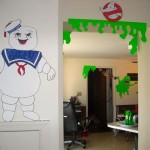Cool Home Office Decor Ideas
The modern professional landscape has undergone a significant transformation, with remote work becoming increasingly prevalent. This shift necessitates the creation of functional and inspiring home office environments. A well-designed workspace can significantly enhance productivity, focus, and overall job satisfaction. This article explores a variety of cool home office decor ideas to transform a dedicated space into a stimulating and effective work environment. These suggestions encompass a range of aesthetic preferences and practical considerations, enabling individuals to tailor their offices to their specific needs and tastes.
1. Prioritize Ergonomics and Functionality
The foundation of any effective home office revolves around ergonomics and functionality. Comfort is paramount, and neglecting this aspect can lead to physical strain and decreased productivity. The initial step involves investing in an ergonomic chair that provides adequate lumbar support and adjustable features. This chair should allow for proper posture and prevent long-term discomfort. A standing desk, or a desk capable of adjusting height, is another excellent investment. Alternating between sitting and standing positions can combat the negative health effects of prolonged sitting and improve energy levels throughout the day. The desk itself should provide ample surface area for all necessary equipment, including a computer, monitor, keyboard, mouse, and any relevant paperwork. Consider the placement of these items carefully to ensure they are within easy reach and positioned to minimize strain on the eyes, neck, and wrists. Ample storage solutions, such as drawers, shelves, and filing cabinets, are crucial for keeping the workspace organized and clutter-free, which contributes to a clearer mind and greater efficiency.
2. Embrace Natural Light and Color Psychology
The interplay of natural light and color has a significant impact on mood and productivity. Whenever possible, position the home office near a window to maximize exposure to natural light. Natural light regulates the body's circadian rhythm, boosting alertness and reducing fatigue. If natural light is limited, supplemental lighting is essential. Utilize a combination of ambient, task, and accent lighting to create a well-lit and inviting atmosphere. Ambient lighting, such as overhead fixtures or lamps, provides general illumination for the room. Task lighting, like a desk lamp, focuses light on the work area, improving visibility for detailed tasks. Accent lighting, such as wall sconces or decorative lamps, adds visual interest and ambiance. The choice of colors for the home office also plays a crucial role in establishing an optimal working environment. Cool, calming colors like blues, greens, and soft grays promote focus and reduce stress. Warmer colors, such as yellows and oranges, can stimulate creativity and boost energy levels, but can also be distracting if overused. Integrating plants into the decor adds a touch of nature, improves air quality, and contributes to a sense of tranquility. Consider incorporating a variety of sizes and types to add visual depth and interest.
3. Define Zones and Create Visual Interest
Even within a confined space, the home office can benefit from carefully considered zoning. This involves defining separate areas within the office for different activities. For example, a dedicated work area can house the desk, computer, and essential equipment. A relaxation area can provide a comfortable seating arrangement, such as a sofa or armchair, for taking breaks or informal meetings. Defining these zones helps to maintain a sense of order and prevent the workspace from feeling overwhelming. Incorporating visual interest is achieved in several ways, including the use of artwork, photographs, and decorative objects. Displaying art that resonates with an individual's personal preferences provides a source of inspiration and visual pleasure. Photographs of loved ones, or inspiring quotes, can add a personal touch and create a more welcoming atmosphere. Decorative objects, such as sculptures, vases, or unique desk accessories, can infuse the space with personality and style. Thoughtfully curated decor elements can transform a utilitarian space into a reflection of personal identity and taste.
4. Maximize Space with Smart Storage Solutions
Space optimization is a key consideration, particularly in smaller home offices. Smart storage solutions are essential for keeping the workspace organized, clutter-free, and visually appealing. Utilize vertical space by installing bookshelves, floating shelves, or wall-mounted storage units. This frees up valuable floor space and provides ample room for storing books, files, and office supplies. Consider utilizing storage furniture with multiple functions, such as a desk with built-in drawers or a file cabinet that doubles as a printer stand. This maximizes space efficiency and reduces the need for separate pieces of furniture. Employ organizers, containers, and bins to organize desk drawers, shelves, and cabinets. Clear containers allow for easy identification of contents, promoting efficiency and minimizing wasted time searching for items. Decluttering regularly is crucial to maintain an organized and functional workspace. Regularly discard unnecessary items and purge files to prevent clutter accumulation and maintain an efficient workflow.
5. Integrate Technology Seamlessly
A modern home office necessitates seamless technology integration. Evaluate the technology needs of the workspace and ensure adequate power outlets, Wi-Fi connectivity, and cable management solutions. Ensure that there are sufficient power outlets at the desk and throughout the office to accommodate all necessary devices. Invest in a multi-port charging station to streamline charging of multiple devices simultaneously. A reliable and high-speed internet connection is essential for online work, communication, and research. Consider upgrading to a faster internet plan if necessary. Effective cable management is crucial for maintaining a tidy and organized workspace. Utilize cable ties, cable organizers, and cable trays to conceal and manage cords, preventing clutter and potential hazards. Consider wireless peripherals, such as a wireless keyboard, mouse, and printer, to minimize cable clutter and enhance mobility. Incorporate smart home technology to control lighting, temperature, and other office features remotely, optimizing convenience and efficiency.
6. Personalize the Space for Enhanced Comfort
Personalization is the key to creating a home office that truly reflects individual preferences and enhances comfort. Incorporate elements that reflect personal interests and hobbies. Displaying items that inspire and motivate can foster a positive and productive work environment. Add personal touches such as photographs, artwork, or souvenirs. These items transform the workspace into a more welcoming and inviting environment. Utilize comfortable seating, such as an ergonomic chair with adjustable features, is essential for maintaining physical well-being. Choose a chair that provides adequate lumbar support and allows for proper posture. Incorporate elements of biophilic design, which involves integrating natural elements into the design, enhances the overall ambiance of the space. This can include plants, natural materials, and organic forms. These elements can create a calming and restorative atmosphere. Consider adding a diffuser with essential oils to create a more relaxing and stimulating aroma.
7. Optimize Acoustics for Focus
Sound management is a crucial element in achieving focus and productivity within the home office. Excessive noise can distract and hinder concentration. Employ sound-dampening materials to minimize noise distractions. Consider using acoustic panels, soundproof curtains, or thick rugs to absorb sound and reduce reverberation. Position the workstation away from sources of distractions. Distance the desk from noisy areas, such as a television or high-traffic areas. Use noise-canceling headphones to block out external sounds and create a focused work environment. Choose the sound-masking machine or app as a source of ambient noise. These tools can mask distracting sounds and create a more consistent soundscape. Consider the acoustics of the office during the design phase. This can include the selection of materials, the placement of furniture, and the arrangement of the workspace.

20 Inspirational Home Office Decor Ideas

35 Home Office Decor Ideas Designs For A Creative Work Space

30 Best Home Office Decor Ideas 2025

Home Office Ideas Interior Design Decor And Layout Tips Decorilla

35 Home Office Decor Ideas Designs For A Creative Work Space

Small Home Office Makeover 10 Budget Friendly Decor Ideas Organize By Dreams

45 Best Home Office Ideas Decor Photos

12 Chic Home Office Decor Ideas No Repeats Or Hesitations

20 Home Office Decor Ideas In 2025 Oppein

21 Diy Home Office Decor Ideas Best Projects







